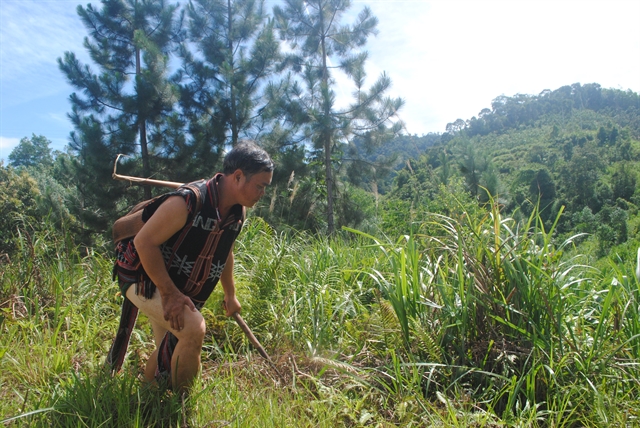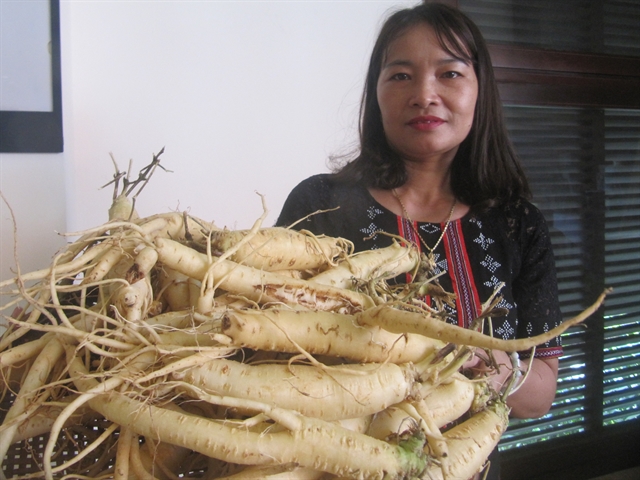 Society
Society


|
| A local ethnic Cơ Tu farmer clears his timber farm in central Quảng Nam Province. Many people in Thừa Thiên Huế and Quảng Nam provinces benefitted from the United States Agency for International Development (USAID) Green Annamites Project from 2016-20. VNS Photo Công Thành |
QUẢNG NAM — Nearly 30,000 people have benefitted from improved natural resource management and biodiversity conservation thanks to the Green Annamites Project in Quảng Nam and Thừa Thiên-Huế provinces.
The project has been sponsored by the United States Agency for International Development (USAID) from 2016-20.
It also reduced the amount of carbon dioxide released per year into the atmosphere by 11.6 million tonnes – 10 times the amount caused by Việt Nam’s airline industry.
Director of the Green Annamites Project, Daniel Lopez, said: “Over the past four years, the USAID Green Annamites project has invested US$23.9 million to help the provinces of Quảng Nam and Thừa Thiên-Huế to protect the region’s globally significant biodiversity and help local and ethnic minority communities to diversify and improve their livelihoods.”
“USAID has trained 15,254 people on sustainable landscapes and 9,669 people on natural resource management and biodiversity conservation; supported the improved natural resource management of 512,000ha of biological significant land; contributed to 13,387 people receiving livelihood co-benefits and 15,321 people receiving increased economic benefits from improved natural resource management and biodiversity conservation,” he said.
The project had also mobilised $59.8 million in external investment for value chain development, women’s economic empowerment, medicinal plants and handicrafts production, and forest restoration work.
Mission Director Ann Marie Yastishock said: “It has been a great honour for USAID to collaborate with partners from Thừa Thiên-Huế and Quảng Nam to advance their commitment to strengthen the livelihoods of mountainous communities, conservation enterprise development, biodiversity conservation, and forest restoration and management.”

|
| A Cơ Tu member of the Ginseng Co-operative in Gary Commune, Quảng Nam Province displays ginseng roots at an exhibition organised by the United States Agency International Development (USAID)-funded Green Annamites Project. VNS Photo Công Thành |
“The success of the USAID Green Annamites project and the strong collaboration between the Quảng Nam and Thừa Thiên-Huế People’s committees to implement this effort have contributed to the enhanced development co-operation between Việt Nam and the United States,” she added.
USAID will continue to support biodiversity conservation in the two provinces for the next five years through the recently awarded USAID Biodiversity Conservation and USAID Sustainable Forest Management projects.
These new projects will enable the continuation of the beneficial approaches developed under the Green Annamites Project, transferring positive benefits to other provinces and communities in Việt Nam.
Chairman of Quảng Nam People’s Committee Lê Trí Thanh praised the success of the project, saying it had surpassed its goals in terms of carbon emissions, improved management, fundraising, livelihood benefits, biodiversity protection and climate change resilience.
“We would like to express our sincere thanks to USAID for the financial and technical assistance during the project's implementation over the past four years. It has helped improve the capability of our management staff, while creating sustainable livelihoods for the community and protecting natural resources,” Thanh said.
“The project has also helped improve incomes for more than 17,000 people, while value chains for timber forests and medicinal herbs have emerged,” he said.
Võ Danh Dự, chairman of Thừa Thiên-Huế's Forest Owners’ Sustainable Development Association (FOSDA), said 1,500 forest owners – six times more than the initial partners – had got involved in sustainable forest development in the province.
He said many timber farm owners could earn VNĐ350 million ($15,000) per hectare, while protecting natural forests.
Lê Bá Ngọc, chairman of the Việt Nam Crafts Export Association (VietCraft), said about 600 households in 14 rural mountainous communes across Quảng Nam Province had benefitted from the Green Annamites Project.

|
| Rattan products are made from products sourced from sustainable forest and medicinal herb farms in Thừa Thiên Huế Province. Local people in Quảng Nam and Thừa Thiên-Huế provinces are being trained in sustainable forest development and natural forest protection. VNS Photo Công Thành |
“The project helped 150 households increase their incomes by 65 per cent in just 13 months from farming sustainable medicinal herbs. 400 other households were trained in forestry processing and received technical assistance to cultivate 100ha of rattan,” Ngọc said.
“Trade and craft production links were built between local ethnic groups with five businesses and eight shops in Hà Nội and HCM City. Contracts worth a total of VNĐ2 billion ($87,000) for craft production and sale were inked between local people and those businesses,” he said.
Ngọc said 721 households, of which 370 belonged to ethnic Cơ Tu women, had started sustainable crafts production as part of the project.
The project also helped revive traditional brocade weaving and rattan crafts while discouraging illegal hunting and logging.
Coor Thị Ích, a Cơ Tu woman from Gary Commune in Tây Giang District, said the ethnic group previously lived from forestry exploitation, but the project had helped change their lives for the better.
“Many members of our ginseng co-operative earn VNĐ70 million ($3,000) per year. We have been trained how to grow ginseng sustainably and create high value products,” she said.
Ích said ethnic groups still needed assistance to classify and preserve ginseng seeds for longer crops.
The Green Annamites Project also helped Quảng Nam Province launch a new elephant conservation area in Nông Sơn District, while conduct biodiversity monitoring, and raise conservation awareness among locals. — VNS




